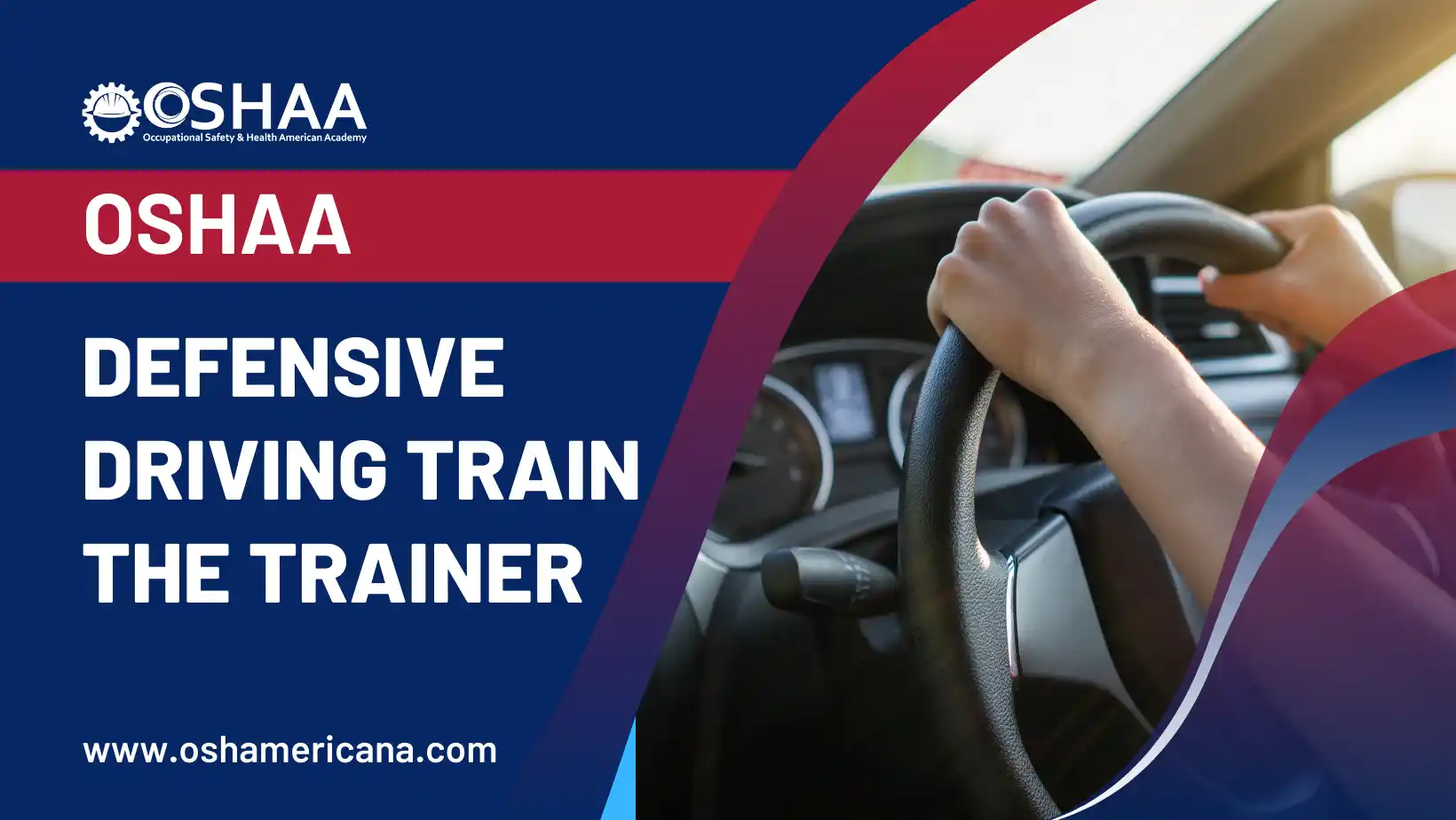Enhance your expertise and career prospects with the OSHAA Defensive Driving Train the Trainer course, designed to build safer driving practices and reduce accidents.
The OSHAA Defensive Driving Train the Trainer course is a specialized professional program tailored to address the increasing need for skilled defensive driving instructors in today’s high-traffic environment. With the growing number of vehicles on the road and the alarming rise in accident statistics, the demand for qualified trainers who can deliver impactful and effective road safety education has never been more urgent. This comprehensive course provides participants with advanced knowledge, proven strategies, and practical tools to train others in defensive driving, equipping them to lead initiatives that minimize risks, prevent collisions, and promote a culture of responsible driving.
Central to the OSHAA Defensive Driving Train the Trainer program is the preparation of professionals who can serve as safety leaders and educators. The curriculum encompasses essential areas such as hazard recognition, accident prevention, traffic law compliance, risk management, and proactive decision-making in complex driving conditions. Participants learn how to evaluate diverse road environments, anticipate potential hazards, and impart these critical skills to others, ensuring that their training sessions remain both engaging and impactful. Through a balance of theory and hands-on application, learners become fully capable of delivering defensive driving instruction that enhances road safety at both individual and organizational levels.
The course places strong emphasis on regulatory compliance, ensuring that trainers are well-versed in updated traffic laws, driver responsibilities, and international standards for road safety. By embedding compliance into defensive driving education, the program not only strengthens the credibility of trainers but also ensures that the knowledge they share aligns with globally recognized practices. This approach enhances both learner confidence and organizational accountability, creating a safer driving culture that meets legal and professional requirements.
In addition to technical knowledge, the OSHAA Defensive Driving Train the Trainer course develops the interpersonal and instructional skills necessary for successful teaching. Participants refine their ability to communicate effectively, engage diverse audiences, and use modern training methodologies to motivate learners. Emphasis is placed on leadership and role modeling, enabling trainers to influence positive driving behavior while fostering a culture of safety within communities and workplaces. By mastering these skills, graduates of the program are positioned not only as instructors but also as advocates for road safety excellence.
Completion of the OSHAA Defensive Driving Train the Trainer course represents both professional advancement and a meaningful contribution to public well-being. Participants emerge as qualified trainers who can design and lead defensive driving programs, reduce accident rates, and save lives. The program is particularly beneficial for safety officers, corporate trainers, driving instructors, fleet managers, and professionals responsible for organizational safety initiatives. With the expertise gained, participants become key assets to their organizations and play an active role in building safer roads and safer work environments.
Ultimately, the OSHAA Defensive Driving Train the Trainer course is more than just a qualification; it is a commitment to safety, compliance, and professional leadership. By enrolling, learners take a decisive step toward becoming influential trainers who shape driving behavior, uphold industry standards, and make a lasting difference in road safety. This course equips professionals with the knowledge and authority to lead defensive driving initiatives that protect lives, support compliance, and advance a culture of safety in today’s fast-moving world.
OSHAA Defensive Driving Train the Trainer
To enroll in the OSHAA Defensive Driving Train the Trainer course, learners are expected to meet the following criteria:
Age Requirement
- Applicants must be at least 18 years old to participate in the OSHAA Defensive Driving Train the Trainer course, ensuring that all participants have the maturity and responsibility required to undertake professional safety training.
Educational Background
- A minimum of a high school diploma or equivalent is recommended for enrollment in the OSHAA Defensive Driving Train the Trainer course. While not mandatory, higher education in safety, transportation, or a related field provides an added advantage and can further support learners in grasping the regulatory and instructional aspects of the program.
Work Experience
- Prior work experience in training, safety, transportation, or driving instruction is not required but is highly beneficial. Participants with experience in road safety, fleet management, or workplace training will find the OSHAA Defensive Driving Train the Trainer course particularly valuable in enhancing their professional expertise and expanding their instructional capabilities.
English Proficiency
- Learners must have the ability to read, write, and speak English proficiently. Strong English skills are essential for understanding course materials, delivering training sessions effectively, and ensuring compliance with regulatory standards presented throughout the OSHAA Defensive Driving Train the Trainer course.
This eligibility framework ensures that participants enrolling in the OSHAA Defensive Driving Train the Trainer program are fully prepared to succeed, gain maximum value from the training, and apply their knowledge to promote safer driving practices across organizations and communities.
Study Units
Learning Outcomes
The OSHAA Defensive Driving Train the Trainer course is designed to provide participants with the advanced knowledge, practical skills, and leadership abilities needed to become effective safety trainers in road and workplace environments. Through a structured curriculum, learners gain expertise in compliance with traffic laws, hazard prevention, instructional design, and communication strategies. These learning outcomes ensure that participants not only understand the principles of defensive driving but are also prepared to lead training programs that enhance road safety, reduce risks, and foster a strong safety culture across organizations.
- Introduction to Defensive Driving
- Understand the fundamental principles of defensive driving and how they apply to reducing accidents and improving safety outcomes.
- Recognize the role of defensive driving in protecting drivers, passengers, and organizations from risk and liability.
- Develop the ability to explain defensive driving concepts clearly to diverse learner groups in training environments.
- Traffic Laws and Regulations
- Gain comprehensive knowledge of local, national, and international traffic laws relevant to safe driving practices.
- Understand the legal responsibilities of drivers and trainers, ensuring compliance with regulatory standards.
- Stay updated on the latest regulatory requirements and integrate them effectively into training sessions.
- Hazard Recognition and Risk Management
- Identify common road hazards, including environmental, mechanical, and human-related risks.
- Learn proactive strategies to anticipate and respond to potential driving hazards.
- Apply risk management principles to reduce accident rates and enhance organizational safety performance.
- Designing Effective Training Programs
- Acquire the skills to design structured defensive driving training modules tailored to different audiences.
- Incorporate adult learning principles into course design to ensure engagement and knowledge retention.
- Develop course content that aligns with OSHA and international safety standards.
- Training Delivery Techniques
- Master modern instructional methods, including classroom, simulation, and on-the-road training approaches.
- Build confidence in delivering engaging and interactive training sessions.
- Adapt training delivery techniques to suit varied learning styles and professional contexts.
- Communication and Leadership Skills
- Enhance interpersonal and communication skills required for effective safety training.
- Develop leadership qualities to inspire learners and promote a culture of safety within organizations.
- Strengthen conflict resolution and team-building abilities to foster collaboration during training.
- Emergency Preparedness and Response
- Gain knowledge of emergency response procedures applicable to driving incidents and workplace accidents.
- Train others to respond effectively to accidents, injuries, and unexpected road hazards.
- Integrate emergency preparedness into training programs to build resilience and confidence among learners.
- Evaluation and Continuous Improvement
- Learn how to assess the effectiveness of defensive driving training programs through feedback and performance metrics.
- Apply continuous improvement strategies to refine course content and delivery.
- Cultivate a mindset of ongoing development to ensure training remains relevant, effective, and compliant with safety standards.
By completing the OSHAA Defensive Driving Train the Trainer course, participants are fully equipped to lead defensive driving initiatives, ensure compliance with regulatory requirements, and create safer environments for drivers and organizations. Graduates of this course become safety leaders who are capable of designing, delivering, and improving training programs that make a measurable impact on road safety and organizational performance.
The OSHAA Defensive Driving Train the Trainer course offers a wide range of professional and organizational benefits designed to elevate safety standards, reduce risks, and promote long-term operational success. This program equips participants with the advanced knowledge, practical skills, and leadership abilities required to deliver effective defensive driving training. For industry professionals, organizations, and stakeholders, the course is not only a pathway to compliance with safety regulations but also a powerful tool for fostering a proactive safety culture and professional development. Recognized globally for its relevance and impact, the OSHAA Defensive Driving Train the Trainer course prepares participants to lead initiatives that improve driver performance, enhance organizational efficiency, and reduce incidents across industries.
- Comprehensive Knowledge of Defensive Driving
Learners gain a deep understanding of defensive driving principles, including hazard anticipation, proactive decision-making, and risk avoidance strategies. This knowledge allows trainers to teach safe driving practices that significantly reduce road accidents. - Regulatory Compliance and Legal Protection
The course provides thorough coverage of OSHA requirements and traffic laws, ensuring that trainers and their organizations remain compliant. By embedding these regulations into training, professionals minimize legal risks and strengthen organizational accountability. - Improved Road Safety Performance
Participants acquire the expertise to train others in techniques that directly reduce accidents, collisions, and traffic violations. This results in safer roads, fewer injuries, and greater confidence among employees and stakeholders. - Professional Development and Career Advancement
Graduates of the OSHAA Defensive Driving Train the Trainer course enhance their credentials with an internationally recognized qualification. This professional development opportunity strengthens their career prospects and positions them as leaders in safety training. - Cost Savings and Operational Efficiency
By reducing accident-related costs such as vehicle repairs, medical expenses, and downtime, organizations achieve significant savings. Efficient training also leads to improved operational productivity and better resource management. - Leadership and Communication Skills
The program strengthens leadership and communication abilities, enabling trainers to inspire learners and effectively convey safety-critical information. These skills are valuable for building trust and driving cultural change within organizations. - Hazard Recognition and Risk Management
Learners develop strong analytical skills to identify risks, evaluate hazards, and implement mitigation strategies. This expertise is critical in preventing accidents and fostering safer driving practices across various industries. - Emergency Preparedness and Response
Participants gain the ability to integrate emergency response strategies into training programs. This ensures drivers are well-prepared to act effectively in the event of accidents, mechanical failures, or hazardous conditions. - Cultural Shift Toward Safety
By equipping trainers with effective instructional strategies, the course promotes the development of a strong safety culture. Employees trained under this framework adopt safer habits that enhance overall organizational resilience. - Confidence in Training Delivery
The course provides practical tools and methodologies that empower trainers to deliver engaging, impactful, and learner-focused defensive driving sessions with confidence and authority. - Global Recognition of Certification
The OSHAA Defensive Driving Train the Trainer certification is internationally respected, giving participants credibility across borders and industries. This recognition enhances employability and mobility in global markets. - Enhanced Worker Well-Being and Productivity
Safer driving practices not only protect workers but also reduce stress, fatigue, and accident-related disruptions. As a result, employees experience improved well-being and productivity. - Continuous Improvement and Innovation
The course emphasizes ongoing evaluation and adaptation of training programs. Trainers learn to apply feedback, monitor effectiveness, and innovate, ensuring long-term relevance and effectiveness in their teaching methods. - Organizational Reputation and Stakeholder Trust
Organizations that invest in the OSHAA Defensive Driving Train the Trainer program demonstrate their commitment to safety. This strengthens trust with stakeholders, clients, and regulatory bodies while enhancing corporate reputation. - Long-Term Impact on Safety Standards
Beyond immediate benefits, the course empowers trainers to influence lasting improvements in road safety and organizational practices. This long-term impact contributes to sustainable growth and operational excellence.
By completing the OSHAA Defensive Driving Train the Trainer course, participants gain far more than technical knowledge; they acquire the ability to lead, influence, and drive meaningful change. This program not only enhances compliance and safety outcomes but also equips trainers with the professional recognition, leadership skills, and confidence to make a measurable difference in road safety and organizational performance worldwide.
The OSHAA Defensive Driving Train the Trainer course is designed for professionals and organizations committed to elevating road safety standards, reducing risks, and ensuring compliance with OSHA regulations and international best practices. This program is particularly relevant for industry professionals, safety leaders, and stakeholders seeking to enhance their training capabilities, strengthen workplace safety standards, and promote a culture of compliance. Globally recognized, the OSHAA Defensive Driving Train the Trainer course provides essential professional development opportunities, preparing participants to lead safety initiatives with confidence and expertise.
- Safety Managers
- Play a central role in developing and implementing workplace safety programs, including driver safety initiatives.
- The OSHAA Defensive Driving Train the Trainer course is directly relevant as it provides them with the tools to design and deliver impactful training.
- They gain advanced skills in hazard recognition, training design, and compliance leadership.
- This program strengthens their ability to enforce OSHA compliance, reduce incidents, and improve operational efficiency.
- Operations Supervisors
- Oversee daily operations where transportation and driver safety are critical to productivity.
- The OSHAA Defensive Driving Train the Trainer course equips them to monitor, guide, and train staff in safe driving practices.
- They develop stronger leadership, communication, and incident prevention skills.
- Their enhanced training capacity helps organizations remain OSHA-compliant while maintaining smooth and safe operations.
- HSE Officers
- Responsible for health, safety, and environmental standards across organizations, including vehicle and driver safety.
- This course empowers them to integrate defensive driving training into broader HSE programs.
- They acquire expertise in risk management, emergency preparedness, and compliance monitoring.
- By applying skills from the OSHAA Defensive Driving Train the Trainer course, HSE officers strengthen safety culture and compliance standards.
- HR and Training Professionals
- Manage employee development, onboarding, and training programs within organizations.
- The OSHAA Defensive Driving Train the Trainer course supports them in incorporating defensive driving into employee training initiatives.
- They gain knowledge in curriculum design, effective delivery techniques, and evaluation methods.
- Their role ensures that organizations meet OSHA requirements while improving employee confidence and safety awareness.
- Professional Drivers and Driving Instructors
- Serve as the frontline in implementing safe driving practices across industries.
- The OSHAA Defensive Driving Train the Trainer course enhances their ability to teach, mentor, and influence safe driving behaviors.
- They develop deeper knowledge of traffic laws, hazard recognition, and defensive strategies.
- Completing this course positions them as certified leaders in promoting OSHA-compliant road safety programs.
- Corporate Leaders and Business Owners
- Hold responsibility for organizational safety, compliance, and overall performance.
- The OSHAA Defensive Driving Train the Trainer course helps them build sustainable training frameworks that align with global safety standards.
- They gain insights into reducing costs related to accidents, downtime, and legal liabilities.
- Their commitment to this training enhances corporate reputation, stakeholder trust, and long-term operational resilience.
By addressing the needs of diverse roles, the OSHAA Defensive Driving Train the Trainer course ensures that participants across industries gain the knowledge, professional skills, and certifications required to improve safety, strengthen compliance, and foster operational excellence. Whether for safety managers, operations leaders, training specialists, or professional drivers, this globally recognized program prepares participants to lead road safety initiatives that deliver lasting organizational impact.







